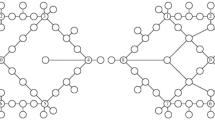Abstract
Changes in the functional characteristics of a multicommodity network with cluster architecture of the logical links depending on damages of edges of its physical topology graph are studied. The concept of a cluster damage is defined as a damage that separates at least one vertex from its sinks. The analysis is carried out on the class of minimum cluster damages. The stability of each cluster of logical links is analyzed with respect to the set of damages when the damage is not directly aimed at the source vertex of the cluster. Estimates of the cluster integrity on the whole and in terms of the undamaged (undivided) links remaining in the cluster are obtained. These estimates provide a basis for bi-criteria ranking of clusters depending on their susceptibility to nonrandom damages of the network. Characteristics of the minimum cluster damages and methods for their comparison are proposed. This approach can be used for a quick analysis of vulnerability of large territorially distributed systems, including telecommunication, communication, and control systems.



Similar content being viewed by others
REFERENCES
V. V. Velichko, V. K. Popkov, and G. V. Popkov, Models and Methods of Increasing the Survivability of Modern Communication Systems (Goryachaya liniya, Moscow, 2017) [in Russian].
A. K. Levakov, Operational Features of Next Generation Telecommunication Systems in Emergency Situations (IRIAS, Moscow, 2012) [in Russian].
D. J. Watts and S. H. Strogatz, “Collective dynamics of ’small-world’ networks,” Nature, No. 393 (6684), 409–410 (1998).
T. H. Grubesic, T. C. Matisziw, A. T. Murray, et al. “Comparative approaches for assessing network vulnerability,” Int. Regional Sci. Rev. 31 (1), 88–112 (2008).
M. A. Alim, N. P. Nguyen, D. N. Thang, et al., “Structural vulnerability analysis of overlapping communities in complex networks,” Proc. of the 2014 IEEE/WIC/ACM Int. Conf. on Web Intell., WI ’14 (ACM, New York, 2014), pp. 231–235.
T. Gomes, C. Esposito, D. Hutchison, F. Kuipers, J. Rak, and M. Tornatore, “A survey of strategies for communication networks to protect against large-scale natural disasters,” Int. Workshop on Reliable Networks Design and Modeling (RNDM), 2016, pp. 11–22.
A. Kuhnle, N. P. Nguyen, T. N. Dinh, and M. T. Thai, “Vulnerability of clustering under nodes failure in complex networks,” Social Network Anal. Mining 7 (1), 8–24 (2017).
J. Ponton, P. Wei, and D. Sun, “Weighted clustering coefficient maximization for air transportation networks,” Control Conf. (ECC), 2013. pp. 866–871.
F. Frank and I. T. Frish, Communication, Transmission and Transportation Networks (Addison-Wesley, Reading, Mass., 1971; Svyaz’, Moscow, 1978).
L. R. Ford and D. R. Fulkerson, Flows in Networks (Princeton Univ. Press, Princeton, 1962; Mir, Moscow, 1966).
P. A. Jensen and J. W. Barnes, Network Flow Programming (Wiley, New York, 1980; Radio i Svyaz’, Moscow, 1984).
Yu. B. Germeier, Introduction to the Theory of Operations Research (Nauka, Moscow, 1971) [in Russian].
Yu. E. Malashenko, I. A. Nazarova, and N. M. Novikova, “An approach to the analysis of possible structural damages in multicommodity network systems,” Comput. Math. Math. Phys. 59, 1562–1575 (2019).
A. A. Assad, “Multicommodity network flows: A survey,” Networks 8 (1), 37–91 (1978).
C. H. Papadimitriou and K. Steiglitz, Combinatorial Optimization: Algorithms and Complexity (Prentice-Hall, Englewood Cliffs, 1982; Mir, Moscow, 1985).
Yu. E. Malashenko, I. A. Nazarova, and N. M. Novikova, “Fuel and energy system control at large-scale damages. IV. A priori estimates of structural and functional vulnerability,” J. Comput. Syst. Sci. Int. 57, 907–920 (2018).
Yu. E. Malashenko, I. A. Nazarova, and N. M. Novikova, “Vulnerability analysis of multi-polar networks after structural damages,” Inform. Primen. 13 (1), 33–39 (2019).
M. Lalou, M. A. Tahraoui, and H. Kheddouci, “The critical node detection problem in networks: A survey,” Comput. Sci. Rev. 28, 92–117 (2018).
M. Ventresca, K. R. Harrison, and B. M. Ombuki-Berman, “The bi-objective critical node detection problem,” Eur. J. Oper. Res. 265, 895–908 (2018).
J. Li, P. M. Pardalos, B. Xin, and J. Chen, “The bi-objective critical node detection problem with minimum pairwise connectivity and cost: Theory and algorithms,” Soft Comput. 23, 12729–12744 (2019).
Author information
Authors and Affiliations
Corresponding authors
Additional information
Translated by A. Klimontovich
Rights and permissions
About this article
Cite this article
Malashenko, Y.E., Nazarova, I.A. & Novikova, N.M. Analysis of Cluster Damages in Network Systems. Comput. Math. and Math. Phys. 60, 341–351 (2020). https://doi.org/10.1134/S0965542520020098
Received:
Revised:
Accepted:
Published:
Issue Date:
DOI: https://doi.org/10.1134/S0965542520020098




